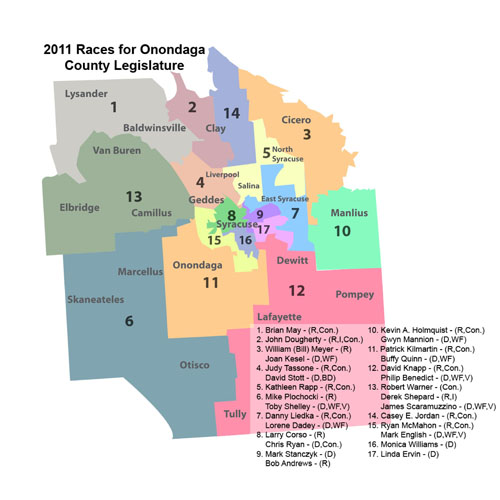More women and more newcomers highlight voters’ choices for the Onondaga County Legislature in November.
And the variety is good for public affairs, say political experts.
“The more diversity you have in the legislature, the more ideas there are, the better the solutions you come up with,” said Kristi Andersen, a political science professor at Syracuse University.
For the county legislature, all 17 seats are up for election. Eleven of them are contested races with at least two candidates. Women are candidates in half of the races — the largest proportion of female candidates in the county’s history. And the fresh political faces are 14 candidates who’ve never run for the legislature before.
The election is Nov. 8.
The greater variety in candidates, say political scientists and experts on local government, are largely the result of more women coming into grassroots politics, some upheavals inside the local Republican Party and the recent redistricting that encouraged some candidates to try their luck in newly designed districts.
Women candidates are making county history by running in eight of the 17 legislative districts. Those women include three incumbents who have no challengers: Kathleen Rapp, R-Liverpool, of District 5; Monica Williams, D-Syracuse, of District 1; and Linda Ervin, D-Syracuse, of District 17.
In District 4, incumbent Judy Tassone, R-Liverpool, faces a rematch against David Stott, a Democrat from Salina lost to Tassone in 2009.
Four other women are among the fresh faces running for the legislature for the first time. All four are Democrats. They are Joan Kesel of Cicero in District 3, Lorene Dadey of East Syracuse in District 7, Gwyn Mannion of Fayetteville in District 10 and Buffy Quinn of Syracuse in District 11.
Women are often drawn into politics by a particular issue such as education, green energy or pollution, said political scientist Kristi Andersen. “For women, career politics is much less of pipeline into office,” Andersen said, because society often doesn’t encourage women to go into politics.
Some of the fresh faces in the legislature races are the result of recent upheaval in the Onondaga County Republican Committee. In a rare move, the party dropped two incumbents from its endorsements and chose two new candidates. The change also created the legislature’s only three-way race.
For District 12, the GOP declined to endorse incumbent Robert Cox, R-Pompey, who had been appointed by County Executive Joanie Mahoney in March. Instead, the party endorsed David Knapp, a Republican serving on the Lafayette Town Council since 1999. Knapp retained the GOP endorsement by beating Cox in the Sept. 13 primary.
For District 13 , the county GOP dropped 20-year incumbent Robert Warner, R-Baldwinsville. The party chose Derek Shepard, a Republican member of Van Buren Town Board since 2007. Shepard also beat Warner in the Sept. 13 primary.
But Warner remains on the ballot as the Conservative Party candidate, setting up the three-way race with him, Shepard and Democrat James Scaramuzzino of Baldwinsville, who ran and lost in 2009.
He decided to seek re-election, Warner said, to limit turnover in the legislature and to offer his experienced perspective on county issues. Warner received about 40 percent of the vote in the primary against Shepard.
“I’ve been around for 20 years. People know everything they need to know about me,” Warner said. “Turnover is huge this year, the largest I’ve seen. That’s another reason I’ve decided to run — I’ll provide some stability.”
In District 13, taxes have risen more than 100 percent. That’s the reason, Warner and other Republicans said, the party decided not to endorse him.
His opponent, Derek Shepard, highlights taxes as his top issue. If elected, he said, he’ll clearly explain to his constituents why they’ve increased.
The third District 13 candidate, James Scaramuzzino, a local chef, plans to go line by line in the county budget to cut costs. He’s specifically interested in cutting from legislators’ travel budgets and other overlooked areas, if he’s elected, Scaramuzzino said.
The variety of new candidates comes partly from the county legislature’s redistricting, say political scientists. With some re-designed districts, new candidates saw better odds for winning, say political scientists.
In April, the legislature had to cut the number of seats from 19 to 17, in response to the latest U.S. Census showing population shifts. The legislature cut one Republican and one Democratic district. Republicans remained in control of the legislature, though their majority changed from 12-7 seats to 11-6 seats.
That sparked some changes in candidates by encouraging some retirements of incumbents, said SU political scientist Jeff Stonecash. “There are always more retirements around reapportionment time because a lot of people decide, ‘I’ve got a new constituency. I’ll have to work hard, they don’t know who I am,’” said Stonecash. Some conclude, he said, “ ‘I just don’t want to do it.’”
But incumbency is still a strong force in the November election. Eleven of the 17 legislators are seeking re-election.
For example, in District 10, Kevin Holmquist, R-East Syracuse, is running for his fourth term. He faces one of the women newcomers in Gwyn Mannion. He’s seeking re-election in part because his district was barely changed at all and his constituency is still familiar with him, he said.
“I’m quite confident,” Holmquist said. “Ours is one district that didn’t really change.”
(Beckie Strum is a senior majoring in newspaper journalism and Middle Eastern studies.)
-30-



